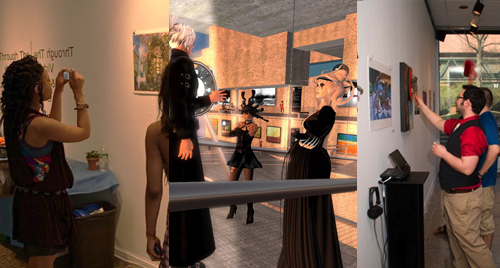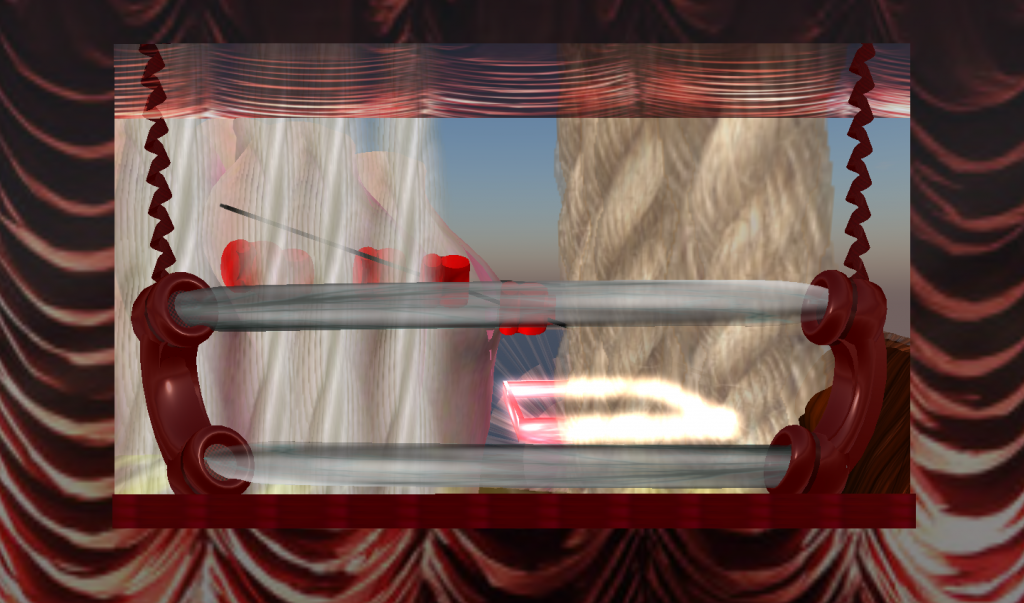I like using the word ‘totality’ as in the ‘totality of one’s surroundings.’ Self provides the essentials of our internal existence and environment is the external display of all that. The environment presents our existence as individuals to others. Through Web 2.0, the conceptual platform that facilitates creativity, information sharing, and, most important, collaboration, we have been able to extend the material or real environment. Art in virtual 3D worlds implement new possibilities for environments that are perceived and accessible from a unique set of dimensions. Each aesthetic-technological dimension has been used as a basis for artistic experimentation here except for one. Georg Janick AKA Dr. Gary Zabel writes,
Environment fluidity is to the external virtual world what the protean character of identity is to the internal sphere. In Second Life, for example, the environment is constructed from graphical primitives and scripts that can be altered very rapidly. Constancy of environment is the exception rather than the norm. It is in the virtual world that Marx’s famous observation about capitalist modernity first reaches fruition: All that is solid melts into air.
[youtube:https://www.youtube.com/watch?v=n3NvtqtjLBY]
When I began writing my first post last week I knew that, eventually, I would return to the topic of participation in virtual art that originates in both real and artificial environments. Central to the exhibition of virtual art is the integral involvement of 3D avatars (and the humans driving them), the traditional elements of visual and time-based art, new aesthetic-technological dimensions, and the ephemeral qualities of art produced in immersive 3D space. This requires a distinctly different way of solving problems, thinking about new issues, and communicating ideas to a broad, evolving audience.
As an example of environmental fluidity, check out Through the Virtual Looking Glass, a mixed reality virtual art project currently being exhibited in real life and Second Life by a network of international art collectives, including the Caerleon sims/Virtual Art Initiative and the Pirats Art Network. I interviewed the founders to close my current Art21 blogging stint but first here is a recap of the main themes explored in my previous posts.
[youtube:https://www.youtube.com/watch?v=MUYEPBNg474]
Art in virtual 3D space transcends physical constraints and traditional concepts of time and space. Art production in virtual 3D worlds brings digitally mediated art within a frame of contemporary, conceptual work. Artists are actively involved in this new media context, which is characterized by lower barriers of entry to artistic expression, production, and engagement. Web 2.0 has come to play an integral part in the expansion of new art forms because it increasingly enables artists to work collaboratively; generate and disseminate information, ideas, and creative works; and connect with people who share similar goals and interests.
[youtube:https://www.youtube.com/watch?v=RlfYDN8a8OM]
Realities, other than the material world we live in, have existed for centuries. In essence, what defines human consciousness is the ability to imagine other “realities,” starting with the nuances such as sound, inflection, pauses, gestures, and other subtle signs. Art in virtual 3D worlds can activate real emotions. Immersive 3D artworks often simulate the real life experience of being in material space. You lose your critical distance to the experience and get emotionally involved. You feel as if the art is very real but know it is not.
[youtube:https://www.youtube.com/watch?v=hR7WevkoIsk]
Artists are employing software agents act for users as part of their art in virtual worlds. Agents have flexible behaviors that are reactive, responsive, and social. Using scripts, artists can transform objects into virtual robots inhabited by software agents that work behind the scenes while human-driven avatars interact or become immersed in the art. Additionally, the use of interactive HUDs (heads up displays) attached to avatars as gallery guides, HTML on a prim to apply external web content as textures on 3D objects, and bringing in online social media, such as Twitter, to engage visitors and foster real life and virtual connections.
Misprint Thursday sent me a notecard for Suspended Hang-Ups, her contribution as part of Selavy Oh’s contribution for the Best of Brooklyn Is Watching exhibition at Jack the Pelican Presents in Brooklyn, NY. It reads,
Suspended Hang-Ups is an installation which explores concepts of psychological, emotional and cultural “hang-ups.” The driving emotive factors in this work stem from ideas about communication, persona, persona as performance, and a myriad of layered metaphors for the user to discover.
When the user wears the HUD (Heads Up Display), their avatar screen view is transformed into a surreal stage. The viewer then has the creative user interface at their hands to click on parts of the HUD (the stage and objects) to create what becomes a combined experience of an art installation and performance. The work is user driven. The cause/effect element in the work leads the viewer in a curious experience.
The piece is portable, and can be both passive by only wearing the HUD as part of a user experience to frame the view or active by clicking the HUDs parts and creating/rezzing the installation/performance.
Selavy Oh had invited fellow artists to show their work within the show. Selavy provided the virtual gallery space, a multiplied and distorted labyrinth of Jack the Pelican Presents replicas connected to each other and providing a separate gallery for each of them. Misprint was one of the artists experimenting with interactivity as part of their installations, which give visitors more to do than just navigate their avatars through the virtual art on view. The overarching goal was to immerse visitors in an environment that engenders very different perceptual experiences and creates wide variations in the conditions of their observations. Additionally virtual 3D worlds encourage artists who may be collaborating on similar themes to push past the boundaries of what is possible in real life.
[youtube:https://www.youtube.com/watch?v=LcXR0Qir6XI]
For doppelgänger, SL artist Mab Macmoragh collaborated with several artists, some who have previous been featured on Art:21:
- Cao Fei (China Tracy)- iMirror, 2007 (China)
- Patrick Lichty (Man Michinaga)- CodePortraits, 2009 (USA)
- Gazira Babeli- iGods, 2009 (Italy)
- Adam Nash (Adam Ramona), Christopher Dodds (Christo Kayo), Justin Clemens (Jack Shoreland)- Autoscopia, 2009 (Australia)
- Andrew Burrell (Nonnatus Korhonen)- temporary self-portrait in preparation for the singularity, 2009 (Australia)
Regarding doppelgänger Mab writes,
This 21st century doppelgänger is an abbreviated look at the virtual exhibition held by the National Portrait Gallery, Canberra, on Portrait Island in Second Life® from 23 October 2009 to 23 April 2010. There are lots of texts in it that go by quickly, so the viewer is urged to pause the video as needed to read the various signs, notecards, web pages, and words incorporated into the artwork.
I was holding a spot to interview Jean-Marc Larroque AKA Newbab Zsigmond and Nathalie Gobé AKA Merlina Rokocoko, founders of Pirats Art Network but the US/French time difference proved problematic. I met Newbab at the Museaav opening, as part of Through the Virtual Looking Glass on April 4. Since then I’ve visited two other Pirats’ exhibitions and witnessed how active the group has been in Second Life. If possible, I will include other information from them in the comments section. The Netherlands also joined in with their own real life/SL exhibition on Sunday, April 18. This show includes work from Aristide Desprez AKA Philippe Moreaux who I interviewed for Art & the Avatar: Ambiguity of Identity in Virtual 3D Worlds.
[https://www.youtube.com/watch?v=D5-TOofb1ss]
Dr. Gary Zabel AKA Georg Janick helped coordinate Through the Virtual Looking Glass, including the Harbor Gallery exhibition at UMass Boston. He notes multiple methods of allowing visitors to cross from the real world to the virtual world and back again. The real-life exhibition consists of slide shows in digital frames, machinimas displayed on a digital cinema screen, large scale digital projection of SL and RG, the use of a specialized RL device (a sculptural beehive) for interaction with Mellifera by Nonnatus Korhonen and Neurone Schism, and real paintings and sculptures inspired by SL art. Dr. Zabel sees this exhibition as a starting point for exploring further modes of real-world/virtual world synergies.
Dr. Gary Zabel in SL writes,
Environmental fluidity is suggested in the exhibition through the use of slide shows in digital frames, and multiple looping machinimas on a cinematic computer monitor. In both cases the viewer witnesses a reality that is in the process of continual transformation. The “real” 3d works – the paintings, sculptures, and so on – anchor the gallery audience in a stable environment, but the new media work introduces them to a world that has no final stability, a world in which our relationship to people and things must be constantly renegotiated. Globalization, urbanization, and the development of a media-saturated society have plunged us into a relentlessly fluid environment whether we like it or not. One contribution that virtual artists might make is assisting us in mastering these some exhilarating, and often unsettling conditions of contemporary experience.
I developed my “Theses on the Art of Virtual Worlds” in order to guide the concrete collaborative work of the Caerleon Sims and the Virtual Art Initiative. We are currently in the midst of a project to explore the six “dimensions” of virtual art I discuss in my Theses through six collaborative projects. We have already completed the collaborations on immersion, interaction, and networked collaboration, and are currently engaged in a project on artificial agency. All six collaborations ought to be concluded by the end of August. Based on the results of the collaborations as well as other research, we intend to write a book on the art of virtual worlds that explores in some detail what makes that art a genuinely new aesthetic adventure.
I hope that my recent contributions to this blog and the Art 2.1 column have been interesting, informative, and insightful. I had a lot of fun documenting virtual art, interviewing artists from around the world, and researching art practice and theory concerning virtual art in immersive 3D spaces like Second Life and Reaction Grid. I look forward to continuing a discourse via Facebook, Twitter, or face-to-face, in a classroom or gallery in the very near future. I encourage Art21 blog readers to ask questions, post comments, or offer their feedback.







Pingback: Me, AM Radio & Tezcatlipoca « SL Art HUD Blog Thingie:
Pingback: Creative Metamedia: Augmented Reality Art Production « SL Art HUD Blog Thingie:
Pingback: Art21 2009 to the Present « SL Art HUD Blog Thingie: